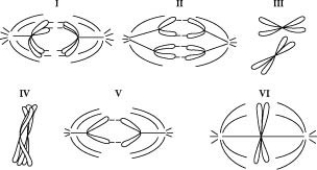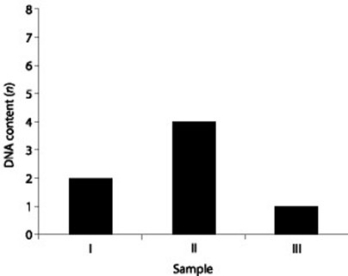A) Homologous chromosomes align on the metaphase plate in meiosis II.
B) Sister chromatids separate in mitosis, and homologous chromosomes separate in meiosis II.
C) Meiosis II occurs in a haploid cell, while mitosis occurs in diploid cells.
D) Crossing over of chromosomes takes place in meiosis II.
Correct Answer

verified
Correct Answer
verified
Multiple Choice
How do cells at the completion of meiosis compare with cells that are in prophase of meiosis I?
A) The cells have half the number of chromosomes and half the amount of DNA.
B) The cells have the same number of chromosomes and half the amount of DNA.
C) The cells have half the number of chromosomes and one-fourth the amount of DNA.
D) The cells have half the amount of cytoplasm and twice the amount of DNA.
Correct Answer

verified
Correct Answer
verified
Multiple Choice
The two homologs of a pair move toward opposite poles of dividing cell during
A) mitosis.
B) meiosis I.
C) meiosis II.
D) fertilization.
Correct Answer

verified
Correct Answer
verified
Multiple Choice
Refer to the information and figure below to answer the following questions.
A certain (hypothetical) organism is diploid, has either blue or orange wings as the consequence of one of its genes on chromosome 12, and has either long or short antennae as the result of a second gene on chromosome 19, as shown in the figure.
 -If a female of this species has one chromosome 12 with a blue gene and another chromosome 12 with an orange gene, and has both number 19 chromosomes with short genes, which of the following combinations of genes will her eggs have?
-If a female of this species has one chromosome 12 with a blue gene and another chromosome 12 with an orange gene, and has both number 19 chromosomes with short genes, which of the following combinations of genes will her eggs have?
A) only blue short gene eggs
B) only orange short gene eggs
C) one half blue short and one half orange short gene eggs
D) three fourths blue short and one fourth orange short gene eggs
Correct Answer

verified
Correct Answer
verified
Multiple Choice
Which of the following statements is correct regarding the human X chromosomes?
A) It is present in every somatic cell of males and females.
B) It is the same size as other chromosomes and has the same number of genes.
C) It carries genes that determine an individual's biological sex.
D) It is referred to as an autosome.
Correct Answer

verified
Correct Answer
verified
Multiple Choice
Asexual reproduction occurs during which of the following processes?
A) meiosis
B) mitosis
C) fertilization
D) the exchange of chromosomes between organisms of different species
Correct Answer

verified
Correct Answer
verified
Multiple Choice
The bulldog ant has a diploid number of two chromosomes. Therefore, following meiosis, each daughter cell will have a single chromosome. In addition to mutations, how might genetic diversity be generated in this species?
A) crossing over only
B) independent assortment only
C) crossing over and random fertilization
D) nothing else
Correct Answer

verified
Correct Answer
verified
Multiple Choice
Which of the following characteristics do homologous chromosomes exhibit?
A) They carry information for different traits.
B) They carry information for the same traits.
C) They carry the same alleles.
D) They align on the metaphase plate in meiosis II.
Correct Answer

verified
Correct Answer
verified
Multiple Choice
Which of the following processes occurs in a plant's sexual life cycle?
A) sporophytes produce gametes by meiosis
B) gametophytes produce gametes by mitosis
C) gametophytes produce gametes by meiosis
D) sporophytes produce gametes by mitosis
Correct Answer

verified
Correct Answer
verified
Multiple Choice
Which of the following statements describes a major difference between mitosis and meiosis I in a diploid organism?
A) Sister chromatids separate in mitosis, while homologous pairs of chromosomes separate in meiosis I.
B) Sister chromatids separate in mitosis, while homologous pairs of chromosomes separate in meiosis II.
C) DNA replication takes place prior to mitosis, but not before meiosis I.
D) Only meiosis I results in daughter cells that contain identical genetic information.
Correct Answer

verified
Correct Answer
verified
Multiple Choice
A triploid cell contains three sets of homologous chromosomes. If a cell of a diploid species that normally has 42 chromosomes per cell is triploid, this cell would be expected to have which of the following sets of chromosomes?
A) 63 chromosomes in 31 1/2 pairs
B) 63 chromosomes in 21 sets of 3
C) 63 chromosomes, each with 3 sister chromatids
D) 21 chromosome pairs and 21 unique chromosomes
Correct Answer

verified
Correct Answer
verified
Multiple Choice
Refer to the drawings in the figure below of a single pair of homologous chromosomes as they might appear during various stages of either mitosis or meiosis, and answer the following question(s) .
 -Which diagram represents anaphase I of meiosis?
-Which diagram represents anaphase I of meiosis?
A) I
B) II
C) IV
D) V
Correct Answer

verified
Correct Answer
verified
Multiple Choice
Which of the following statements is correct in comparing sexual and asexual reproduction?
A) Asexual reproduction, but not sexual reproduction, is characteristic of only plants and fungi.
B) In sexual reproduction, individuals transmit half of their nuclear genes to each of their offspring.
C) In asexual reproduction, offspring are produced by fertilization without meiosis.
D) Asexual reproduction produces only haploid offspring.
Correct Answer

verified
Correct Answer
verified
Multiple Choice
Refer to the information and figure below to answer the following questions.
A certain (hypothetical) organism is diploid, has either blue or orange wings as the consequence of one of its genes on chromosome 12, and has either long or short antennae as the result of a second gene on chromosome 19, as shown in the figure.
 -A female with a paternal set of one orange and one long gene chromosome and a maternal set comprised of one blue and one short gene chromosome would be expected to produce which of the following types of eggs after meiosis?
-A female with a paternal set of one orange and one long gene chromosome and a maternal set comprised of one blue and one short gene chromosome would be expected to produce which of the following types of eggs after meiosis?
A) All eggs will have maternal types of gene combinations.
B) All eggs will have paternal types of gene combinations.
C) Half the eggs will have maternal and half will have paternal combinations.
D) Each egg has a one-fourth chance of having either blue long, blue short, orange long, or orange short combinations.
Correct Answer

verified
Correct Answer
verified
Multiple Choice
Which of the following statements defines a genome?
A) the complete set of an organism's polypeptides
B) the complete set of a species' polypeptides
C) a karyotype
D) the complete set of an organism's genes and other DNA sequences
Correct Answer

verified
Correct Answer
verified
Multiple Choice
Which of the following statements is true of a species that has a chromosome number of 2n = 16?
A) The species is diploid with 32 chromosomes per cell.
B) The species has 16 sets of chromosomes per cell.
C) Each diploid cell has eight homologous pairs of chromosomes.
D) A gamete from this species has four chromosomes.
Correct Answer

verified
Correct Answer
verified
Multiple Choice
DNA was isolated from three different cell types of the same organism, the relative DNA content for each type was determined, and the results were plotted on the graph shown in the figure below. Refer to the graph to answer the following questions.
 -Which sample of DNA might represent an animal cell in the G₂ phase of the cell cycle prior to meiosis?
-Which sample of DNA might represent an animal cell in the G₂ phase of the cell cycle prior to meiosis?
A) I
B) II
C) III
D) both I and II
Correct Answer

verified
Correct Answer
verified
Multiple Choice
DNA was isolated from three different cell types of the same organism, the relative DNA content for each type was determined, and the results were plotted on the graph shown in the figure below. Refer to the graph to answer the following questions.
 -Which sample of DNA might be from a cell that stopped the process of cell division in G₀ phase of the cell cycle prior to meiosis?
-Which sample of DNA might be from a cell that stopped the process of cell division in G₀ phase of the cell cycle prior to meiosis?
A) I
B) II
C) III
D) either I or II
Correct Answer

verified
Correct Answer
verified
Multiple Choice
During which of the following phases of meiosis do centromeres split and sister chromatids migrate to opposite poles of the cell?
A) anaphase I
B) telophase I
C) anaphase II
D) telophase II
Correct Answer

verified
Correct Answer
verified
Multiple Choice
Which of the following processes occurs in meiosis but not in mitosis?
A) chromosome replication
B) synapsis of chromosomes
C) alignment of chromosomes at the equator
D) condensation of chromosomes
Correct Answer

verified
Correct Answer
verified
Showing 21 - 40 of 64
Related Exams